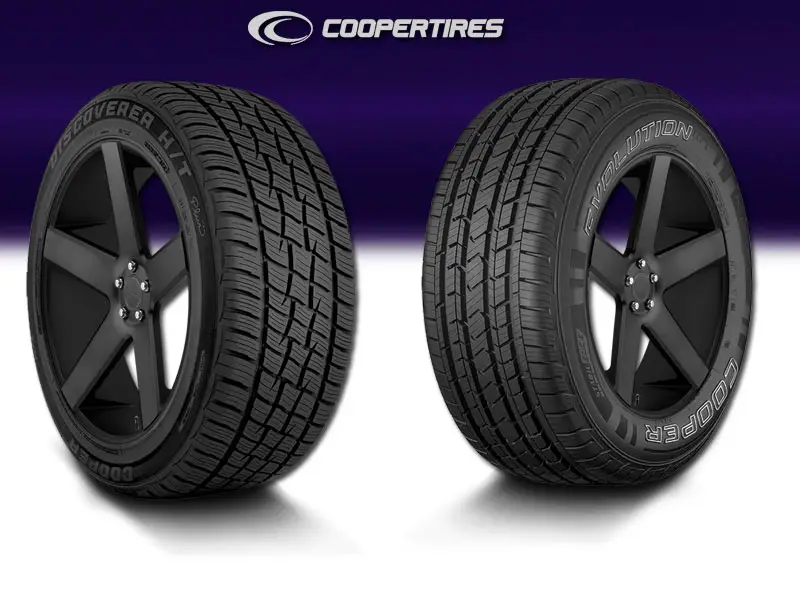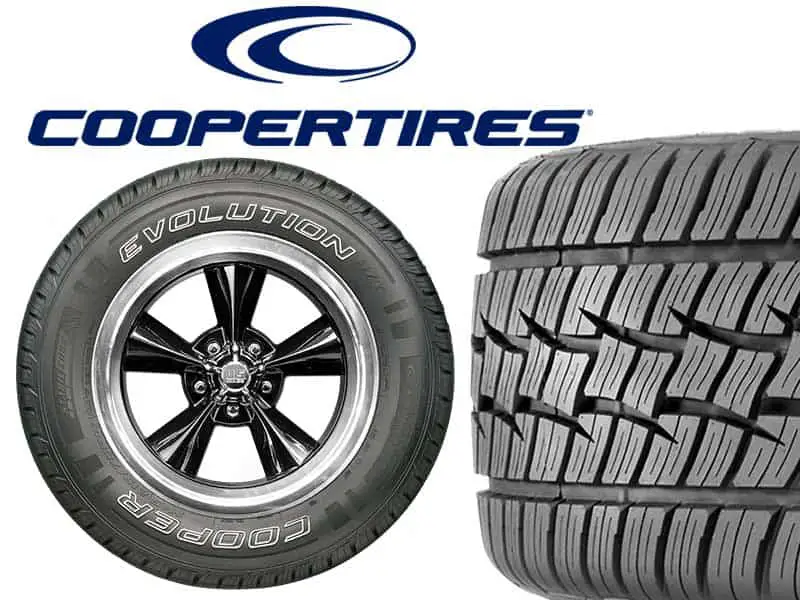Cooper Evolution H/T vs Cooper Discoverer H/T Plus: Both of these are all-season options from Cooper tires, show bulky tread for optimized road traction and deep grooves for a reliable experience in snowy conditions as well.
The Cooper Evolution HT shows sturdy grip ability on both dry and damp roads, moreover, its steer handling is fully commanded and responsive due to its strategically designed shoulders.

Examine the treads on these tires closely. They hold the key to knowing which to choose. In fact if you visit my "tread design" page, picking the right tire would never bother you.
On the other side, the Cooper Discoverer HT plus gives an aggressive look and supreme performance in light snow. It rolls over the road more smoothly and offers a better fuel average.
Table of Contents
Comparing Cooper Discoverer vs Evolution

The Cooper Evolution shows a denser tread having three ribs comprising massive, interlocking, angular blocks and four relatively narrow circumferential grooves in the central portion.
Its shoulders also display a relatively larger surface area as not only the horizontal blocks are wider and have little lateral spacing among them but also a narrow longitudinal rib is present adjacent to each shoulder on its inner side.
It exhibits a 3D micro-Gauge siping pattern with rectilinear, full-depth, and multidirectional sipes marked on all of its blocks.
Discoverer Plus has a comparatively open tread characterizing four wide circumferential grooves among three rows of bold blocks.
Some of the central blocks are notched at their margins for enhanced biting ability.
Longitudinal and lateral channels of its tread display a broad void throughout.
Its shoulder blocks are sturdy, raised, and widely spaced. Unidirectional curved silts over central and marginal blocks represent its reliable siping pattern.
Durability and tread wear
Cooper Evolution stands more durable in the competition due to its sturdy rubber composite.
Its tread is molded from a high silica all-season compound which accounts for superior wet grip and chip resistance.
The internal construction characterizes a two-ply polyester casing and two plies of nylon cap reinforced over two wide, high strength steel belts, this robust structure provides improved stability and puncture resistance. As a result, the tread wears down gradually and evenly over time.
A high UTQG value shows its treadwear resistance, moreover, it is backed by a treadwear protection warranty up to 60,000 miles from the company.
Cooper Discoverer Plus is a fairly durable truck tire but stands below the competitor for longevity. Its tread composition includes Cooper standard all-season rubber, while the internal construction employs 2ply polyester casing, two steel belts, and a single-ply nylon cap reinforcement.
This configuration keeps it functional for a long time, nonetheless, it wears sooner than the competitor.
Low UTQG value shows its faster wear tendency furthermore, it does not have a treadwear protection warranty from the manufacturer either.
Road Grip Comparison
The Cooper Evolution show a better grip on a dry road in the comparison because its tread exhibits a higher contact patch due to bulky interlocking blocks of the central rows and narrow circumferential grooves among them.
As a result, it has more surface area to establish firm contact with the road, accounting for a resolute dry grip.
While rolling over the wet or icy road, 3D micro-Gauge siping and deep voids allow it to roll confidently without wobbling because they remove water from the pavement which may prevent the tread’s grip over the surface.
In areas covered with light snow, its performance is lesser than the competitor’s as its narrow grooves provide less vacuum for the backward evacuation of snow.
Discoverer Plus scores lesser than its competitor for grip on dry tracks because its open tread has decreased proficiency to hold on over the paved surface.
Although notched edges of blocks provide biting ability yet wide lateral spacing makes it difficult to maintain a constant dry grip.
The same story goes on the wet or icy pavement but deeper voids and curved sipes improve its wet/ice grip performance to a reliable extent.
However, on light snow, it performs better than its competitor as broad voids account for efficient evacuation of soft snow and notched blocks bite over the loose surface firmly.
Handling Comparison
Adhering longitudinal ribs along with lateral blocks account for the enhanced handling efficiency of Cooper Evolution over its competitor.
Its Shoulder blocks are wide and compact, having a larger surface area to maintain the grip on the dry road when the pressure comes to shoulders while taking turns.
On a wet road, it again takes the lead in terms of steer management due to its compact shoulder design.
Thin sipes and deep grooves wipe off water and allow the shoulder blocks to grip firmly on the wet or icy pavement while the truck corners along a turn.
It ranks lesser in competition for handling response in snowy areas as narrow and disconnected lateral grooves have minimized capacity to channel out soft snow.
Discover offers a smooth handling experience on dry road but it stands behind its competitor due to its open design.
Less wide shoulder blocks grasp over the pavement less firmly in comparison, decreasing the control over the steer response.
On wet or icy pavements, deeper tread gives it a favor because deep lateral grooves along with curved sipes keep water away and let the shoulders grip strongly.
However, comparatively smaller-sized blocks account for its less efficient wet and ice handling.
In areas covered with light snow, it takes the lead because broad lateral voids connected with longitudinal grooves provide efficient snow evacuation and let the tire maintain traction while taking turns.
Comparison of Hydroplaning Resistance
Both of these tires are designed to minimize hydroplaning, however, Evolution scores a bit higher for this ability as compared with the competitor due to high silica composition and efficient siping pattern.
Frequent, full depth, micro-Gauge, 3D sipes, and various deep grooves provide a stable driving experience over the wet track as they expel water off the tread, and prevent slipping.
Although Discoverer possesses optimized aquaplaning resistance due to its wider grooves and curved sipes.
These open channels provide enough vacuum for routing water efficiently through them and prevent the formation of water-layer beneath the tread.
Curved sipes assist massive grooves in wiping the water away from tread but their unidirectional orientation makes them less efficient in comparison.
Comparison of Rolling Resistance
Evolution faces more rolling resistance as its denser tread characterizes increased biting edges and higher contact patch.
A large surface area in contact with the road requires more energy to roll over, enhanced biting ability makes the task even more energy-soaking as a result, it utilizes a large amount of fuel to compensate for the hysteresis (energy loss) produced against rolling friction.
Discoverer encounters less rolling friction owing to the benefit from its open design.
As it has a lesser contact patch, its tread produces less hysteresis (energy loss), while moving over the paved surface.
The advantage of fuel efficiency comes along with ease of rolling as only a little energy is used against the road friction.
Road Comfort/Noise:
Evolution not only provides a smoother driving experience due to its excellent traction abilities but also accounts for a quieter ride on the highway.
Its compact design allows only minimal space for the reflection and resonation of sound waves which results in low sound production as the tire rolls along.
Conversely, Discoverer displays loud tire sound due to its open tread pattern.
Its deep and wide grooves offer free space for movement and collisions of noisy air particles, producing much noise.
Its open tread accounts for relatively less traction on road, making driving a less comfortable experience in comparison.




